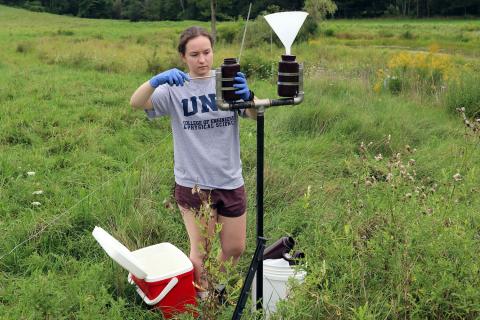RESeARCH GOAL

Measure per- and polyfluoroalkyl substances (PFAS) levels in precipitation, agricultural soils and a regional watershed to better understand the concentration and deposition of these chemicals in the landscape.
About the Researchers

Adam Wymore, Research Assistant Professor of Natural Resources and the Environment
Contact: Adam.Wymore@unh.edu,
ECOSHEDS Lab
Research Team:
UNH College of Life Sciences and Agriculture: Adam Wymore
UNH College of Engineering and Physical Sciences: Paula Mouser
Per- and polyfluoroalkyl substances, or PFAS, are a group of chemicals known for being extremely stable at the molecular level—making them resistant to decomposition and giving them the label of ‘forever chemicals.’ PFAS are found in many industrial and consumer products, with one of the mostly widely known of these substances being Teflon. With more than 5,000 PFAS developed, and hundreds already detected in environmental samples, this chemical class has raised concerns due to their toxicity to humans and animals, as well as health effects that can include cancer, reduced fertility, liver and thyroid diseases.
The presence and persistence of PFAS in water supplies is of particular concern in New Hampshire and the broader New England region because the compounds may accumulate in ecosystems, including in grass-fed and foraging livestock, thus posing significant health and economic impacts. Measuring PFAS levels in precipitation, soils and surface waters will help to better understand how levels change through time and as a function of storm events.
“Most PFAS are long-lived in the environment while others partially break down into smaller PFAS that may be transported through the soil, water and air,” said Adam Wymore, Station scientist and research assistant professor of natural resources and the environment in the UNH College of Life Sciences and Agriculture. “As these chemicals accumulate in the environment, they may move up the food web into food products and livestock.”
While some of the major PFAS sources in our communities have been identified, these substances and others move around the landscape, he added.
“As these chemicals accumulate in the environment, they may move up the food web into food products and livestock.” ~ Adam Wymore, research assistant professor of natural resources and the environment, COLSA
“Our project is specifically looking at a focused list of 40 PFAS that move through the environment in precipitation and runoff,” said Wymore. “These compounds are released through other sources, then move into the atmosphere and are transported along storm tracks before being deposited here in the Northeast.”
The project will study the concentration and composition of PFAS in a watershed located in southeastern New Hampshire. The researchers will examine how PFAS levels change over time; how they differ between different precipitations, like rain and snow; how the direction of precipitation affects PFAS levels; and how PFAS in the soil relates to PFAS in the wet deposition—that is, the process for which substances are deposited from the atmosphere to the Earth’s surface. The research team will do this by collecting rain, soil and stream/river samples in the watershed and measuring for the 40 PFAS in each sample.
According to Paula Mouser, a professor of civil and environmental engineering in the UNH College of Engineering and Physical Sciences, this research comes at a critical time when state and federal agencies are considering health-based regulatory levels for a group of PFAS.
“In March 2023, the EPA proposed drinking water regulations for six PFAS compounds,” said Mouser, “while the New Hampshire Department of Environmental Services (NHDES) is considering regulatory levels for select PFAS in surface waters, biosolids and soils.”
“Understanding how and what PFAS are being deposited across the landscape through precipitation is an important piece of information for stakeholders who may be impacted by the new regulations,” she added.
Understanding PFAS deposition in the region can have economic implications as well, considering that healthcare expenditures related to PFAS exceed $50 billion annually. Additionally, water resource management infrastructure improvements related to the above regulatory actions amount to $1 billion at the state level. Ultimately, this study can inform rulemaking efforts for PFAS in soils and surface waters, contributing to better management and regulation of these chemicals to protect both human health and the environment.


Katherine Wieck '23, a student in the UNH College of Engineering and Physical Sciences' Master's in Civil and Environmental Engineering program, collects rainwater samples from a PFAS collection site located at UNH's Organic Dairy Research Farm in Lee.
“By measuring PFAS concentrations across different location types—from agricultural to urban areas—we’ll also see how PFAS concentrations and profiles vary across the Great Bay watershed. It’s valuable to collect different types of samples—such as precipitation, sediments, and soils—as some PFAS can behave differently in different mediums, resulting in different PFAS concentrations.” ~ Katherine Wieck '23, master's in civil and environmental engineering student, CEPS
This material is based on work supported by the NH Agricultural Experiment Station through joint funding from the USDA National Institute of Food and Agriculture (under Hatch award number 7004133) and the state of New Hampshire.


